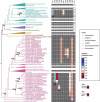Links between gut microbiome composition and fatty liver disease in a large population sample
- PMID: 33651661
- PMCID: PMC7928040
- DOI: 10.1080/19490976.2021.1888673
Links between gut microbiome composition and fatty liver disease in a large population sample
Abstract
Fatty liver disease is the most common liver disease in the world. Its connection with the gut microbiome has been known for at least 80 y, but this association remains mostly unstudied in the general population because of underdiagnosis and small sample sizes. To address this knowledge gap, we studied the link between the Fatty Liver Index (FLI), a well-established proxy for fatty liver disease, and gut microbiome composition in a representative, ethnically homogeneous population sample of 6,269 Finnish participants. We based our models on biometric covariates and gut microbiome compositions from shallow metagenome sequencing. Our classification models could discriminate between individuals with a high FLI (≥60, indicates likely liver steatosis) and low FLI (<60) in internal cross-region validation, consisting of 30% of the data not used in model training, with an average AUC of 0.75 and AUPRC of 0.56 (baseline at 0.30). In addition to age and sex, our models included differences in 11 microbial groups from class Clostridia, mostly belonging to orders Lachnospirales and Oscillospirales. Our models were also predictive of the high FLI group in a different Finnish cohort, consisting of 258 participants, with an average AUC of 0.77 and AUPRC of 0.51 (baseline at 0.21). Pathway analysis of representative genomes of the positively FLI-associated taxa in (NCBI) Clostridium subclusters IV and XIVa indicated the presence of, e.g., ethanol fermentation pathways. These results support several findings from smaller case-control studies, such as the role of endogenous ethanol producers in the development of the fatty liver.
Keywords: Metagenomics; fatty liver; fatty liver index; human gut; population sample.
Figures


Similar articles
-
Characterization of Gut Microbiome in Korean Patients with Metabolic Associated Fatty Liver Disease.Nutrients. 2021 Mar 21;13(3):1013. doi: 10.3390/nu13031013. Nutrients. 2021. PMID: 33801023 Free PMC article.
-
Characterization of gut microbiomes in nonalcoholic steatohepatitis (NASH) patients: a connection between endogenous alcohol and NASH.Hepatology. 2013 Feb;57(2):601-9. doi: 10.1002/hep.26093. Epub 2013 Jan 8. Hepatology. 2013. PMID: 23055155
-
Protection against fibrosis by a bacterial consortium in metabolic dysfunction-associated steatohepatitis and the role of amino acid metabolism.Gut Microbes. 2024 Jan-Dec;16(1):2399260. doi: 10.1080/19490976.2024.2399260. Epub 2024 Sep 6. Gut Microbes. 2024. PMID: 39239875 Free PMC article.
-
Gut microbiota and non-alcoholic fatty liver disease.Hepatobiliary Pancreat Dis Int. 2015 Dec;14(6):572-81. doi: 10.1016/s1499-3872(15)60026-1. Hepatobiliary Pancreat Dis Int. 2015. PMID: 26663004 Review.
-
Influence of gut microbiota on the development and progression of nonalcoholic steatohepatitis.Eur J Nutr. 2018 Apr;57(3):861-876. doi: 10.1007/s00394-017-1524-x. Epub 2017 Sep 5. Eur J Nutr. 2018. PMID: 28875318 Review.
Cited by
-
Characterizing microbiota and metabolomics analysis to identify candidate biomarkers in lung cancer.Front Oncol. 2022 Nov 15;12:1058436. doi: 10.3389/fonc.2022.1058436. eCollection 2022. Front Oncol. 2022. PMID: 36457513 Free PMC article.
-
The gut-liver axis links the associations between serum carotenoids and non-alcoholic fatty liver in a 7.8-year prospective study.Hepatobiliary Surg Nutr. 2025 Feb 1;14(1):16-32. doi: 10.21037/hbsn-23-526. Epub 2024 Jul 15. Hepatobiliary Surg Nutr. 2025. PMID: 39925899 Free PMC article.
-
Polyphenols synergistic drugs to ameliorate non-alcoholic fatty liver disease via signal pathway and gut microbiota: A review.J Adv Res. 2025 Feb;68:43-62. doi: 10.1016/j.jare.2024.03.004. Epub 2024 Mar 11. J Adv Res. 2025. PMID: 38471648 Free PMC article. Review.
-
Antibiotics in Chronic Liver Disease and Their Effects on Gut Microbiota.Antibiotics (Basel). 2023 Sep 22;12(10):1475. doi: 10.3390/antibiotics12101475. Antibiotics (Basel). 2023. PMID: 37887176 Free PMC article. Review.
-
Associations of Fecal Microbiota with Ectopic Fat in African Caribbean Men.Microorganisms. 2024 Apr 17;12(4):812. doi: 10.3390/microorganisms12040812. Microorganisms. 2024. PMID: 38674756 Free PMC article.
References
-
- Chalasani N, Younossi Z, Lavine JE, Diehl AM, Brunt EM, Cusi K, Charlton M, Sanyal AJ. The diagnosis and management of non-alcoholic fatty liver disease: practice guideline by the American association for the study of liver diseases, American College of Gastroenterology, and the American Gastroenterological Association. Hepatology. 2012;55(6):2005–2023. doi:10.1002/hep.25762. - DOI - PubMed
Publication types
MeSH terms
Substances
Grants and funding
LinkOut - more resources
Full Text Sources
Other Literature Sources
Miscellaneous
